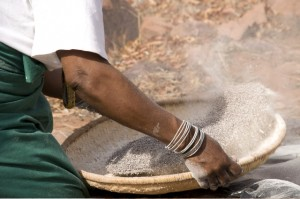- Sweet potato and milk “potaghurt”. Just one way Ghanaian women gain from roots and tubers.
- Another way being through a US$12 million project “to boost yam productivity”.
- Dual purpose crops to sustain livestock and people in India.
- Qocho in Chicago. Calling enset “false-banana” doesn’t do it justice.
- Cowpeas came to Mexico from three separate continents, but is The Beaneater really eating cowpeas? Not necessarily.
- We need to see the trees for the woods, says a new book from ICRAF.
Brainfood: Medicinal plants, Einkorn diversity, Chestnut diversity, Leeks etc, Phylogenetic diversity
- The Use of Phylogeny to Interpret Cross-Cultural Patterns in Plant Use and Guide Medicinal Plant Discovery: An Example from Pterocarpus (Leguminosae. It’s kinda like parallel evolution.
- Genetic diversity in the Red wild einkorn: T. urartu Gandilyan (Poaceae: Triticeae). Northwest Syria and South Turkey contain the most genetic diversity, and genetic similarity is not a proxy for geographic closeness.
- Castanea spp. biodiversity conservation: collection and characterization of the genetic diversity of an endangered species. Overview of a 7-year project to conserve and study sweet chestnut diversity.
- Diversity in Allium ampeloprasum: from small and wild to large and cultivated. The continuing, complex saga of onion, leek and garlic evolution. It’s about heterozygosity, rathen than ploidy.
- Phylogenetic diversity promotes ecosystem stability. How crazy is that!
Nibbles: Ag history, Kuk, Vegetables in PNG, Tonka beans, Bio-villages
- Cambridge University summarizes the 10,000-year journey “from foraging to farming”.
- A journey that’s still taking place at the Kuk Early Agricultural World Heritage Site in Papua New Guinea.
- Where researchers are working with farmers to see which vegetables grow best where.
- Tonka beans (Dipteryx odorata) are the foundation of a conservation programme in Venezuela.
- Bio-villages in Bangladesh, “to improve food security and increase the supply of nutritionally rich food”. Supported by IRRI!
Mufhoho for the masses, finger millet for the rest of us
The Gaia Foundation recently featured a slideshow about the work of the Mupo Foundation. The slideshow is all about finger millet (Eleusine coracana) in Venda, a region of South Africa. Mupo says it:
[S]trengthens local communities in ecological governance by reviving indigenous seed, facilitating and encouraging intergenerational learning, and rebuilding confidence in the value of indigenous knowledge systems.

That kind of language probably wows donors; I hope so. What it comes down to, though, is helping young people to learn from those who have not yet forgotten about crops that are better for them and their environment. Finger millet certainly fits the bill. The Mupo Foundation is gathering, storing and sharing finger millet diversity, promoting its nutritional value, and preserving rituals and traditions that depend on millet. It would be nice to think that they could be funded under a new call for proposals for research on Improving rural livelihoods in Sub-Saharan Africa: Sustainable and climate-smart intensification of agricultural production. Maybe even trialling some of the 5957 varieties that ICRISAT says it has in its genebank, to see whether any can deliver additional benefits under changing climate regimes.
Nibbles: Cannabaceae revisited, Farmer information, Sunflower genes, Urban foraging, Plant hunters, Forest gardens
- Hoping and doping: taxonomy of hops revised.
- What do farmers want? Where do they look for it? How much will they pay? IFPRI has answers.
- Van Gogh’s sunflower mutants explained.
- Gathering in the city: an annotated bibliography and review of the literature about human-plant interactions in urban ecosystems.
- Career advice: Plant Hunters.
- Coffee forest gardens improve food security.